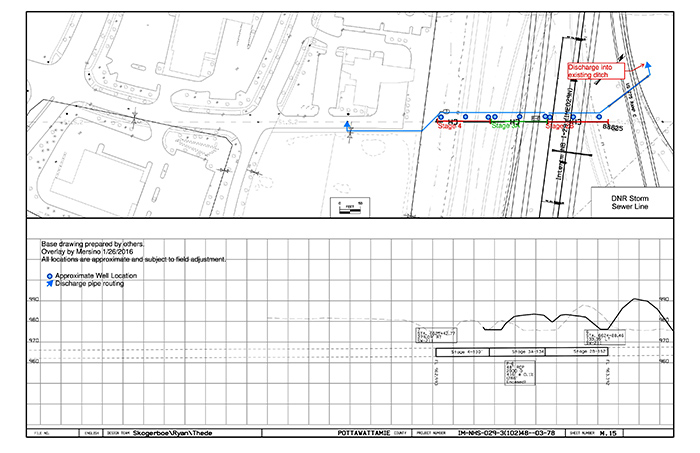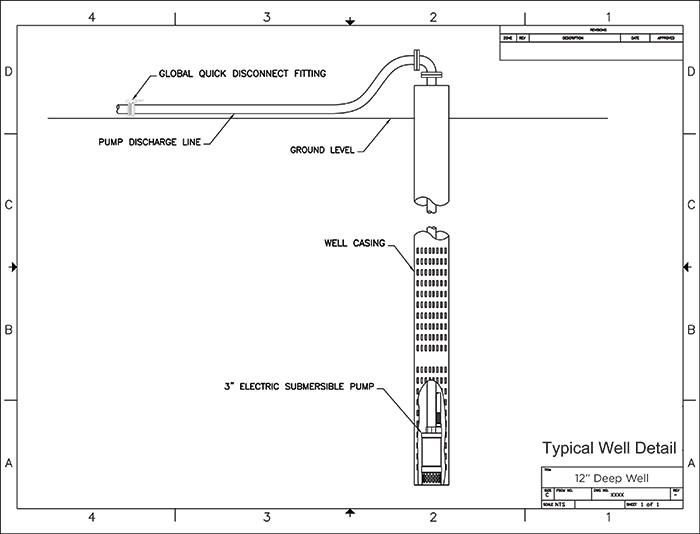Companies should gather data and implement systems to keep job sites dry so contractors can complete their work on time and within budget.
Mersino Dewatering Inc.
11/23/2017
Infrastructure projects often involve excavation work to subgrade depths that require aggressive groundwater control to make construction feasible and safe. Construction dewatering can be achieved by designing and installing a subgrade pumping system that operates continuously to draw down the water table sufficiently to allow work. Dewatering presents unique challenges because the variables relevant to completing a project are not easily identifiable and can often require services beyond what was originally expected.
 Figure 1. DNR storm sewer line (Images and graphics courtesy of Mersino Dewatering)
Figure 1. DNR storm sewer line (Images and graphics courtesy of Mersino Dewatering)Interstate Improvements
The total infrastructure improvement efforts around I-29 in Council Bluffs, Iowa, required the work of many companies, including one that partnered with the general contractors to provide dewatering services. Beginning in mid-2014, one of those companies installed a dewatering system for the installation of a 48-inch storm sewer for the Department of Natural Resources (DNR), which now conveys flows from Mosquito Creek to Lake Manawa. This new storm sewer was a portion of the larger project to demolish and rebuild the I-29 and US-275 intersection. For this project, open cut excavations were required for installation of the 48-inch storm sewer at depths as much as 13 feet below grade. Geotechnical information indicated that site conditions consisted of clay soil with interconnected sand seams extending from the ground surface to depths as much as 30 feet below ground surface, with fine to coarse sand underlying the less permeable soils. Groundwater was encountered as much as four to six feet below grade, and the geotechnical information demonstrated an upward gradient within the natural aquifer, suggesting that hydrostatic pressure would be encountered and would need to be relieved for work to be successfully completed. To efficiently dewater the site, the company proposed a deep well dewatering system adjacent to the pipe alignment. After developing the well, the company installed each additional well in sequential order, approximately 15 feet from centerline of the proposed utility. These deep wells were eventually fitted with 10-horsepower submersible pumps and plumbed into a common header system. Collective discharge waters were conveyed approximately 1,000 linear feet from the system to Mosquito Creek and away from the site. Based on the relatively low permeability of the soils near the invert elevation of the proposed utility, the company advised that an extended, continuous pumping duration would be required to achieve sufficient drawdown. To better affect the dewatering effort, the company targeted the coarser zone of soil underlying the less permeable soils with the screened portion of the deep wells. By pumping the aquifer from the coarse stratum well below invert—given the interconnectedness of the less permeable soils above with those coarser soils below—over time, the drawdown curve from each individual well progressively lowered. This caused an overlap of the conic effect on the water table drawdown from well to well sufficiently below invert, allowing a dewatered excavation to take place. The pumping effort on the coarser aquifer allowed the less permeable soils to be drained over time..jpg) Image 1. Bypass pumps prevented catastrophic sewer interruptions
Image 1. Bypass pumps prevented catastrophic sewer interruptions Related Project
The interchange work on I-29 near the intersection of US-275 included relocation of a 48-inch combined sewer interceptor line. This sewer, one of the main interceptor lines leading to the Council Bluffs Wastewater Treatment Plant south of the city, is vital to providing sewer service to tens of thousands of residents. An interruption would be catastrophic for the city. For this portion of the project, a temporary bypass system capable of diverting flows up to 20,000 gallons per minute (gpm) was proposed. This system flows a distance of 1,400 feet around the work area and back into the sewer downstream of the active construction. The system includes three 18-inch pumps, each configured for flow capabilities of 7,000 gpm for a combined capacity of 21,000 gpm. A fourth pump serves as a backup. In emergency conditions, this pump will automatically turn on through the use of float switches. Each primary pump pulls suction from nine feet below grade through an 18-inch high-density polyethylene (HDPE) suction pipe installed into an existing upstream manhole. The system discharges through a manifold into a single 36-inch HDPE pipe to the downstream manhole about 1,400 feet away. Figure 2. DNR well detail
Figure 2. DNR well detail 
